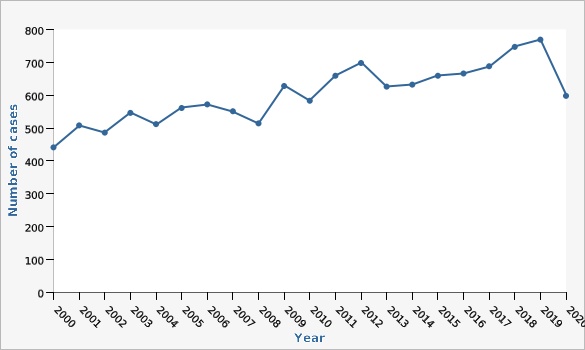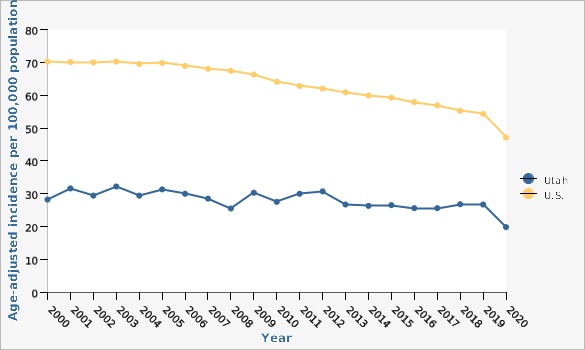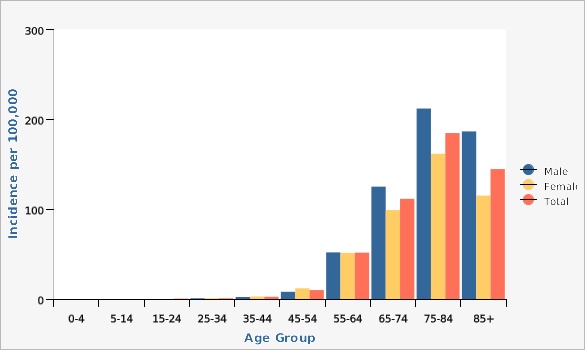Complete Health Indicator Report of Lung cancer incidence
Definition
The rate of lung cancer incidence in Utah per 100,000 population.Numerator
The number of incidents of lung cancer among Utah residents for a given time period (ICD-10: C33-C34).Denominator
The population of Utah or U.S. for a specific time period.Data Interpretation Issues
Cancer diagnoses in 2020 may be impacted by the COVID-19 pandemic due to the changes in health services and cancer screening accessibility.Why Is This Important?
Lung cancer is one of the most common cancers, and is the leading cause of cancer-related death in Utah and the U.S. Because symptoms often do not appear until the disease is advanced, early detection of this cancer is difficult. Cigarette smoking is the single most important risk factor for lung cancer. Tobacco smoke contains thousands of chemicals, many which are known to cause cancer. Cigarette smoking is linked to up to 90% of lung cancer deaths in the United States[1]. Other risk factors associated with lung cancer include exposure to secondhand smoke, radon, asbestos (particularly among smokers), arsenic, diesel exhaust, radiation, air pollution, and family history. Lung cancer is more common in older people, and males are more likely to be diagnosed with lung cancer than females. The U.S. Preventive Services Task Force[2] recommends lung cancer screening for some individuals with a smoking history that puts them at high risk. Lung cancer screening is not without risks, which is why lung cancer screening is only recommended for adults who are at highest risk of the disease[3].[[br]] [[br]] ---- 1 [https://www.cdc.gov/cancer/lung/basic_info/risk_factors.htm][[br]] 2 [https://www.uspreventiveservicestaskforce.org/uspstf/recommendation/lung-cancer-screening][[br]] 3 [https://www.cdc.gov/cancer/lung/basic_info/screening.htm]How Are We Doing?
Utah's incidence of lung cancer has not changed much since 2000.How Do We Compare With the U.S.?
The lung cancer incidence rate in Utah is approximately half the U.S. rate. This is because of less cigarette smoking in Utah compared to other parts of the country. Throughout the U.S., cigarette smoking has been declining over time. The incidence of lung cancer in the United States has been decreasing over time, likely due to reductions in smoking.What Is Being Done?
Since nearly 90% of lung cancer deaths can be attributed to smoking, public health programs to reduce lung cancer focus on tobacco prevention and control. Utah's statewide Tobacco Prevention and Control Program coordinates efforts to accomplish the following four goals: to prevent youth from starting to use tobacco, to help tobacco users quit, to eliminate exposure to secondhand smoke, and to reduce tobacco-related disparities. The Utah Comprehensive Cancer Control program (CCC) and its affiliated coalition, the Utah Cancer Action Network (UCAN), work together with state and local partners to reduce the burden of cancer in Utah. Their mission is to lower cancer incidence, morbidity, and mortality in Utah through collaborative efforts directed toward cancer prevention and control. As a result, they support community-based strategies around food security, healthy neighborhoods, access to health care, and financial toxicity in order to prevent cancer; detect cancer early; and improve the lives of cancer survivors, caregivers, and their families.Available Services
Free services that assist smokers with quitting include the Utah Tobacco Quit Line (1-800-QUIT-NOW) and online resources [https:\\waytoquit.org], and school- and community-based quit programs for teens, adults, and pregnant women.Health Program Information
The Tobacco Prevention and Control Program (TPCP) provides technical expertise and coordination at state and community levels to prevent and reduce tobacco use in Utah. TPCP programs include statewide and community based services to help smokers quit, The TRUTH anti-tobacco marketing campaign, and youth tobacco prevention partnerships with local health departments, schools, and community agencies. The Tobacco Prevention and Control Program monitors smoking prevalence among adult Utahns through the statewide Behavioral Risk Factor Surveillance System and among students through the Youth Risk Behavior Survey.Related Indicators
Relevant Population Characteristics
The risk of developing lung cancer increases with age.Related Relevant Population Characteristics Indicators:
Risk Factors
Cigarette smoking is the most important risk factor for lung cancer. Other risk factors include occupational exposures such as radon and asbestos and indoor and outdoor pollution, including environmental tobacco smoke.Related Risk Factors Indicators:
Health Status Outcomes
In addition to causing lung cancer, smoking also causes heart disease, damages lung function, and raises blood pressure.Related Health Status Outcomes Indicators:
Graphical Data Views
| Utah vs. U.S. | Year | Age-adjusted incidence per 100,000 population | Lower Limit | Upper Limit | ||
|---|---|---|---|---|---|---|
Record Count: 42 | ||||||
| Utah | 2000 | 28.2 | 25.6 | 31.0 | ||
| Utah | 2001 | 31.6 | 28.9 | 34.5 | ||
| Utah | 2002 | 29.4 | 26.9 | 32.1 | ||
| Utah | 2003 | 32.2 | 29.5 | 35.0 | ||
| Utah | 2004 | 29.4 | 26.9 | 32.1 | ||
| Utah | 2005 | 31.3 | 28.7 | 34.0 | ||
| Utah | 2006 | 30.0 | 27.6 | 32.6 | ||
| Utah | 2007 | 28.5 | 26.1 | 31.0 | ||
| Utah | 2008 | 25.5 | 23.3 | 27.9 | ||
| Utah | 2009 | 30.3 | 28.0 | 32.8 | ||
| Utah | 2010 | 27.5 | 25.3 | 29.9 | ||
| Utah | 2011 | 30.0 | 27.7 | 32.4 | ||
| Utah | 2012 | 30.7 | 28.4 | 33.1 | ||
| Utah | 2013 | 26.7 | 24.6 | 29.0 | ||
| Utah | 2014 | 26.3 | 24.2 | 28.4 | ||
| Utah | 2015 | 26.5 | 24.5 | 28.6 | ||
| Utah | 2016 | 25.6 | 23.7 | 27.7 | ||
| Utah | 2017 | 25.6 | 23.7 | 27.6 | ||
| Utah | 2018 | 26.8 | 24.9 | 28.8 | ||
| Utah | 2019 | 26.7 | 24.8 | 28.7 | ||
| Utah | 2020 | 19.8 | 18.2 | 21.5 | ||
| U.S. | 2000 | 70.2 | 69.9 | 70.5 | ||
| U.S. | 2001 | 70.1 | 69.8 | 70.4 | ||
| U.S. | 2002 | 70.0 | 69.7 | 70.3 | ||
| U.S. | 2003 | 70.2 | 69.9 | 70.5 | ||
| U.S. | 2004 | 69.5 | 69.2 | 69.8 | ||
| U.S. | 2005 | 69.8 | 69.5 | 70.1 | ||
| U.S. | 2006 | 68.9 | 68.6 | 69.2 | ||
| U.S. | 2007 | 68.0 | 67.8 | 68.3 | ||
| U.S. | 2008 | 67.4 | 67.1 | 67.7 | ||
| U.S. | 2009 | 66.3 | 66.0 | 66.6 | ||
| U.S. | 2010 | 64.1 | 63.8 | 64.4 | ||
| U.S. | 2011 | 62.8 | 62.6 | 63.1 | ||
| U.S. | 2012 | 62.0 | 61.7 | 62.2 | ||
| U.S. | 2013 | 60.9 | 60.7 | 61.2 | ||
| U.S. | 2014 | 59.9 | 59.7 | 60.2 | ||
| U.S. | 2015 | 59.2 | 59.0 | 59.5 | ||
| U.S. | 2016 | 57.9 | 57.7 | 58.2 | ||
| U.S. | 2017 | 56.9 | 56.7 | 57.2 | ||
| U.S. | 2018 | 55.2 | 55.0 | 55.4 | ||
| U.S. | 2019 | 54.3 | 54.1 | 54.5 | ||
| U.S. | 2020 | 47.1 | 46.9 | 47.3 | ||
Data Notes
Age-adjusted to U.S. 2000 population. [[br]]Data Sources
- Cancer data provided by the Utah Cancer Registry, supported by the National Cancer Institute (HHSN261201800016I), the U.S. Center for Disease Control and Prevention (NU58DP0063200), the University of Utah, and Huntsman Cancer Foundation
- For years 2020 and later, the population estimates are provided by the Kem C. Gardner Policy Institute, Utah state and county annual population estimates are by single year of age and sex, IBIS Version 2022
- Population Estimates for 2000-2019: National Center for Health Statistics (NCHS) through a collaborative agreement with the U.S. Census Bureau, IBIS Version 2020
- U.S. Cancer Statistics: WONDER Online Database. United States Department of Health and Human Services, Centers for Disease Control and Prevention and National Cancer Institute. Accessed at [http://wonder.cdc.gov/cancer.html]
| Males vs. Females | Age Group | Incidence per 100,000 | Lower Limit | Upper Limit | Note | |
|---|---|---|---|---|---|---|
Record Count: 30 | ||||||
| Male | 0-4 | ** | ** | |||
| Male | 5-14 | ** | ** | |||
| Male | 15-24 | ** | ** | |||
| Male | 25-34 | 0.8 | 0.3 | 1.8 | ||
| Male | 35-44 | 2.2 | 1.2 | 3.7 | ||
| Male | 45-54 | 8.0 | 5.7 | 10.9 | ||
| Male | 55-64 | 51.9 | 45.4 | 59.0 | ||
| Male | 65-74 | 125.1 | 113.0 | 138.0 | ||
| Male | 75-84 | 212.0 | 189.1 | 236.9 | ||
| Male | 85+ | 186.6 | 149.8 | 229.6 | ||
| Female | 0-4 | ** | ** | |||
| Female | 5-14 | ** | ** | |||
| Female | 15-24 | ** | ** | |||
| Female | 25-34 | 0.9 | 0.3 | 1.9 | ||
| Female | 35-44 | 2.8 | 1.6 | 4.4 | ||
| Female | 45-54 | 11.9 | 9.0 | 15.4 | ||
| Female | 55-64 | 51.3 | 45.0 | 58.3 | ||
| Female | 65-74 | 99.0 | 88.7 | 110.1 | ||
| Female | 75-84 | 161.7 | 143.4 | 181.7 | ||
| Female | 85+ | 115.1 | 91.0 | 143.7 | ||
| Total | 0-4 | ** | ** | |||
| Total | 5-14 | ** | ** | |||
| Total | 15-24 | 0.4 | 0.2 | 0.9 | ||
| Total | 25-34 | 0.8 | 0.4 | 1.5 | ||
| Total | 35-44 | 2.5 | 1.7 | 3.5 | ||
| Total | 45-54 | 9.9 | 8.1 | 12.1 | ||
| Total | 55-64 | 51.6 | 47.0 | 56.5 | ||
| Total | 65-74 | 111.5 | 103.6 | 119.9 | ||
| Total | 75-84 | 184.7 | 170.2 | 200.2 | ||
| Total | 85+ | 144.6 | 123.5 | 168.3 | ||
Data Notes
**The estimate has been suppressed because 1) the relative standard error is greater than 50% or 2) the observed number of events is very small and not appropriate for publication.Data Sources
- Cancer data provided by the Utah Cancer Registry, supported by the National Cancer Institute (HHSN261201800016I), the U.S. Center for Disease Control and Prevention (NU58DP0063200), the University of Utah, and Huntsman Cancer Foundation
- For years 2020 and later, the population estimates are provided by the Kem C. Gardner Policy Institute, Utah state and county annual population estimates are by single year of age and sex, IBIS Version 2022
- Population Estimates for 2000-2019: National Center for Health Statistics (NCHS) through a collaborative agreement with the U.S. Census Bureau, IBIS Version 2020
| Local Health District | Age-adjusted rate per 100,000 population | Lower Limit | Upper Limit | |||
|---|---|---|---|---|---|---|
Record Count: 14 | ||||||
| Bear River | 17.4 | 14.5 | 20.6 | |||
| Central | 28.1 | 23.4 | 33.4 | |||
| Davis County | 22.3 | 19.9 | 24.9 | |||
| Salt Lake County | 27.3 | 25.9 | 28.8 | |||
| San Juan | 23.3 | 13.9 | 36.5 | |||
| Southeast | 35.3 | 28.4 | 43.5 | |||
| Southwest | 25.3 | 22.9 | 27.8 | |||
| Summit | 26.0 | 18.8 | 35.0 | |||
| Tooele | 34.4 | 27.5 | 42.3 | |||
| TriCounty | 34.8 | 28.0 | 42.9 | |||
| Utah County | 16.7 | 14.9 | 18.6 | |||
| Wasatch | 20.1 | 13.3 | 29.1 | |||
| Weber-Morgan | 27.1 | 24.2 | 30.2 | |||
| State of Utah | 24.8 | 24.0 | 25.7 | |||
Data Notes
Age-adjusted to U.S. 2000 standard population.Data Sources
- Cancer data provided by the Utah Cancer Registry, supported by the National Cancer Institute (HHSN261201800016I), the U.S. Center for Disease Control and Prevention (NU58DP0063200), the University of Utah, and Huntsman Cancer Foundation
- For years 2020 and later, the population estimates are provided by the Kem C. Gardner Policy Institute, Utah state and county annual population estimates are by single year of age and sex, IBIS Version 2022
- Population Estimates for 2000-2019: National Center for Health Statistics (NCHS) through a collaborative agreement with the U.S. Census Bureau, IBIS Version 2020
Lung cancer number of cases by year, Utah, 2000-2020

| Year | Number of cases | |||||
|---|---|---|---|---|---|---|
Record Count: 21 | ||||||
| 2000 | 441 | |||||
| 2001 | 508 | |||||
| 2002 | 486 | |||||
| 2003 | 546 | |||||
| 2004 | 512 | |||||
| 2005 | 561 | |||||
| 2006 | 572 | |||||
| 2007 | 551 | |||||
| 2008 | 514 | |||||
| 2009 | 628 | |||||
| 2010 | 583 | |||||
| 2011 | 659 | |||||
| 2012 | 698 | |||||
| 2013 | 626 | |||||
| 2014 | 632 | |||||
| 2015 | 659 | |||||
| 2016 | 666 | |||||
| 2017 | 688 | |||||
| 2018 | 747 | |||||
| 2019 | 769 | |||||
| 2020 | 598 | |||||
Data Source
Cancer data provided by the Utah Cancer Registry, supported by the National Cancer Institute (HHSN261201800016I), the U.S. Center for Disease Control and Prevention (NU58DP0063200), the University of Utah, and Huntsman Cancer FoundationReferences and Community Resources
Tobacco Prevention and Control Program, Utah Department of Health and Human Services: [http://www.tobaccofreeutah.org][[br]] Tobacco Cessation Program: [https://medicaid.utah.gov/tobacco-cessation-program/][[br]] Centers for Disease Control and Prevention: [https://www.cdc.gov/cancer/lung/basic_info/index.htm][[br]] National Cancer Institute: [https://www.cancer.gov/types/lung][[br]] American Lung Association: [http://www.lung.org][[br]]More Resources and Links
Evidence-based community health improvement ideas and interventions may be found at the following sites:- Centers for Disease Control and Prevention (CDC) WONDER Database, a system for disseminating public health data and information.
- United States Census Bureau data dashboard.
- Utah healthy Places Index, evidence-based and peer-reviewed tool, supports efforts to prioritize equitable community investments, develop critical programs and policies across the state, and much more.
- County Health Rankings
- Kaiser Family Foundation's StateHealthFacts.org
- Medical literature can be queried at PubMed library.
Page Content Updated On 04/24/2024,
Published on 04/26/2024



